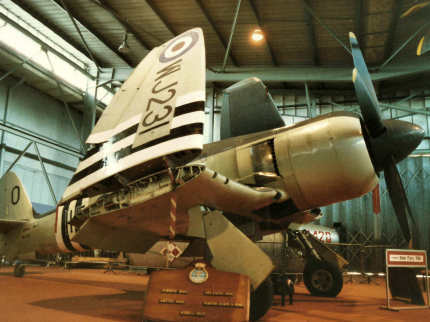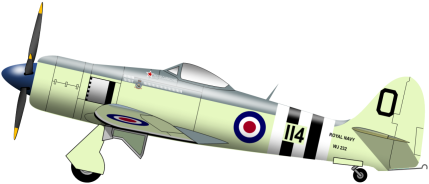
Hawker Sea Fury
In 1942, even before the first Tempest rolled off the production line, Sydney Camm’s design team at Langley began work on its replacement. At the same time the Royal Navy issued a requirement for a similar aircraft for carrier-borne operations.
The new aircraft for the RAF was to be named the Fury and it represented a natural evolution from the Typhoon and Tempest. The Fleet Air Arm version was to be known as the Sea Fury. The first Fury prototype NX798 flew on 1 September 1944 with the second, LA610, on 27 November that year.
Sea Fury first prototype SR661
The new aircraft for the RAF was to be named the Fury and it represented a natural evolution from the Typhoon and Tempest. The Fleet Air Arm version was to be known as the Sea Fury. The first Fury prototype NX798 flew on 1 September 1944 with the second, LA610, on 27 November that year.
As the war drew to a close the RAF began to cancel orders for several aircraft types and they had a surplus of Tempests and late version Spitfires. The Fury would have been an unnecessary addition.
The Royal Navy however, had many aircraft under Lend-Lease from the United States and rather than buy them outright they preferred the idea of replacing them with this new British aircraft, so the Sea Fury programme was continued.
WJ231/115 FB11 is on display in the colours and markings of 802 Squadron, HMS Ocean, at the Fleet Air Arm Museum, Yeovilton. Photograph taken in 1987.
The Fury prototypes continued to be used in the development of the Sea Fury. The first prototype of the naval version, SR661, had an arrester hook but non-folding wings. First flight took place at Langley on 21 February 1945, powered by a Centaurus XII engine. Deck landing trials with this aircraft took place on HMS Ocean in October 1945.
The second prototype, SR666, which first flew on 12 October 1945 did feature folding wings and was powered by a Centaurus XV which drove a five-bladed propeller. The Sea Fury’s fully monocoque design, wide undercarriage and the raised cockpit position giving the pilot a better all-round view made the aircraft a superb carrier-borne fighter-bomber.
The Sea Fury went into production with an order of 200 for the Royal Navy initially built by Boulton-Paul. This order was cut to 100 and subsequent manufacture was carried out at Hawker’s Kingston facility.
Sea Fury FB11 WJ231 of 802 Squadron HMS Ocean is preserved at the Fleet Air Arm Museum, Yeovilton
Korean War
The Korean War began on 25 June 1950–27 July 1953 when communist forces from the north invaded South Korea. Forces from several countries were sent to the war zone under the command of the United Nations. Amongst the ships that the Royal Navy sent was the aircraft carriers HMS Glory and HMS Ocean. The Royal Australian Navy (RAN) sent the carrier HMAS Sydney. All three carriers had Sea Fury Squadrons: RN 804 (Glory) and 802 (Ocean); and RAN 805 and 850 (Sydney).
MiG 15 air combat
On the morning of 9 August 1952 some 15 miles northwest of Chinnampo in what is now North Korea, four Sea Furies of 802 Squadron from HMS Ocean encountered eight MiG 15 jet fighters.
For some reason the MiGs threw away their advantage by slowing down and descending. Lt Peter Carmichael commanding the flight dived on one of the MiGs, closing in to about 300yds firing his 20mm cannon. The shells exploded in the aircraft which went crashing to the ground.
In the ensuing confusion of firing passes, many head-on, Lt Davis and Lt Ellis managed to damage another two MiGs. Two of the Sea Furies suffered minimal damage. The action lasted about four minutes.
MiG-15 of the North Korean Air Force. Many of these aircraft were flown by Russian pilots.
The following day there was a similar incident but this time a MiG got in behind Carmichael but Davis managed to make him break off. Seconds later Davis found himself in a head-on attack. The MiG broke away first. The dogfight lasted about 10 minutes and one of the MiGs was seen heading north trailing black smoke. Incidentally, Lieutenant Peter ‘Toby’ Davis (later Lieutenant-Commander Davis) flew more sorties than any other UN pilot in the Korean War.
Sea Fury FB11 WJ232/114 of 802 Squadron of HMS Ocean during the Korean War. This aircraft was flown by Lieutenant Peter Carmichael who shot down a MiG-15.
Performance Sea Fury FB11
Powerplant 1 x Bristol Centaurus 18, 2,480 hp
Maximum speed 460 at 18,000 ft
Range 700 miles or 1,040 miles with drop tanks
Ceiling 35,800 ft
Rate of climb 4,320 ft/min
Armament consisted of four 20mm cannon and either twelve air to ground rockets or 2,000 lb of bombs. A total of 864 Sea Furies were produced. As well as the RN, Tempests were operated by the Royal Australian Navy, the Royal Canadian Navy and the Pakistan Air Force.
The Royal Navy Historic Flight
In 1972, The Royal Navy Historic Flight (RNHF) was established at RNAS Yeovilton.. In 1995, the ground staff service personnel were replaced by civilian employees but aircrew remain as serving navy pilots who volunteer to spend free time with the RNHF. Air training uses the Flight's DHC Chipmunk.
Over the years, the RNHF has received aircraft of various types from British Aerospace, the German government and the Royal Navy.they also accepted technical assistance with the rebuilds and refurbishments of the aircraft. Three aircraft have been lost in accidents, sadly with two fatalities.
Sea Fury FB11 VR930/110 flies with the Royal Nay Historic Flight in the colours and markings of her original 802 NAS code of '110/Q' when she was first based at RNAS Eglinton, Northern Ireland, and then embarked in HMS Vengeance in 1948.
Sea Fury T20 VX281/VL advanced trainer in the markings of a 799 NAS/50th Traing Air Group based at Yeovilton 1949. It suffered an emergency landing at RNAS Culdrose Air Day 2014. The airframe has been repaired and it is hoped that it will be ready to fly with the Royal Navy Historic Flight for the 2017 display.
A Corgi die cast model of Sea Fury FB 11 TF956 of the Royal Navy Historic Flight. The aircraft represented here was lost in the Firth of Clyde near Prestwick, 10 June 1989
My name is Gary Flint. I'm author, photographer & illustrator for Postcards from Slough. If you wish to make any comments on the contents of the website please click on the ladybird below:
Gary Flint
08/03/1961 - 09/04/2019
Postcards from Slough is an independently funded website. We are open to offers of sponsorship from companies that have any connections to the town. To contact us please click on the ladybird below:
Chalvey Community Forum
Postcards from Slough is linked with a local action group the Chalvey Community Forum. The group liaises with various local organisations in order to improve the quality of life for residents in the ward of Chalvey and Salt Hill. To learn more please click on the maidenhair leaf below:
Museum of Berkshire Aviation
I volunteer as a guide at the Museum of Berkshire Aviation. It is a special museum and if you would like to know more about the museum then please click on the motif below:
To learn more about the museums activities while staying within this website click on the tab at the top of the page or on the motif below:
Graces Guide
Postcards from Slough uses some images from Grace's Guide. Click on the button below:
British Listed Buildings
Postcards from Slough contributes material to British Listed Buildings and uses the site for cross referencing purposes. Click on the button below:








